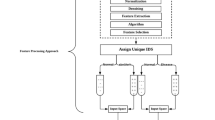Abstract
The diagnosis of cardiac disease is a time-consuming procedure. The presence and magnitude of cardiovascular disease are revealed by the morphology of the electrocardiogram (ECG) sensor signal. The scarcity of instances of the irregular condition collected using ECG sensors is the most significant factor limiting the identification of cardiac disease. In this study, we use a Chebyshev function, also known as Chebfun, to solve the problem of cardiac disease detection with fewer ECG sensor signals. The Chebfun uses its coefficients to approximate the signal. Instead of the traditional handcrafted features, these coefficients, known as Chebfun coefficients, are used as features. With these features of Chebfun, the present work aims to give an interpretation of the features learned by the model for cardiac disease detection. The proposed work makes use of a machine learning algorithm to tackle the problem of better performances using fewer ECG sensor signals. Machine learning algorithms such as SVM, logistic regression, decision tree, and AdaBoost are used in this study.
Access this chapter
Tax calculation will be finalised at checkout
Purchases are for personal use only
Similar content being viewed by others
References
Pan J, Tompkins WJ (1985) A real-time QRS detection algorithm. IEEE Trans Biomed Eng 3:230–236
Desai U et al (2015) Machine intelligent diagnosis of ECG for arrhythmia classification using DWT, ICA and SVM techniques. In: 2015 annual IEEE India conference (INDICON). IEEE, pp 1–4
Kalidas V, Tamil L (2017) Real-time QRS detector using stationary wavelet transform for automated ECG analysis. In: 2017 IEEE 17th international conference on bioinformatics and bioengineering (BIBE). IEEE, pp 457–461
Kiranyaz S, Ince T, Gabbouj M (2016) Real-time patient-specific ECG classification by 1-D convolutional neural networks. IEEE Trans Biomed Eng 63(3):664–675
Xia Y et al (2018) Detecting atrial fibrillation by deep convolutional neural networks. Comput Biol Med 93:84–92
Rocha BM, Filos D, Mendes L, Serbes G, Ulukaya S, Kahya YP, Jakovl-jevic N, Turukalo TL, Vogiatzis IM, Perantoni E, Kaimakamis E (2019) An open-access database for the evaluation of respiratory sound classification algorithms. Physiol Measur 40(3):035001
Gowri B, Ganga KP, Soman, Govind D (2018) Improved epoch extraction from telephonic speech using Chebfun and zero frequency filtering. Interspeech, pp 2152–2156
Mohan N, Soman KP (2018) Power system frequency and amplitude estimation using variational mode decomposition and Chebfun approximation system. In: 2018 twenty-fourth national conference on communications (NCC). IEEE, pp1–6
Chen G (2016) A gentle tutorial of recurrent neural networks with error backpropagation. arXiv preprint arXiv:1610.02583
Engelse WAH, Zeelenberg C (1979) A single scan algorithm for QRS-detection and feature extraction. Comput Cardiol 6(1979):37–42
Christov II (2004) Real-time electrocardiogram QRS detection using a combined adaptive threshold. Biomed Eng online 3(1): 28
Kalidas V, Tamil L (2017) Real-time QRS detector using stationary wavelet transform for automated ECG analysis. In: 2017 IEEE 17th international conference on bioinformatics and bioengineering (BIBE). IEEE, 457–461
Śmigiel S, Marciniak T (2017) Detection of QRS complex with the use of matched filtering. In: Innovations in biomedical engineering. Springer, Cham, pp 310–322
Platte, RB, Trefethen LN (2008) Chebfun: a new kind of numerical computing. progress in industrial mathematics at ECMI 2008. Springer, Berlin, Heidelberg, pp 69–87
Author information
Authors and Affiliations
Editor information
Editors and Affiliations
Rights and permissions
Copyright information
© 2022 The Author(s), under exclusive license to Springer Nature Singapore Pte Ltd.
About this chapter
Cite this chapter
Bhanu Prakash, M., Sanjana, K., Ganga Gowri, B., Sowmya, V., Gopalakrishnan, E.A., Soman, K.P. (2022). Detection of Cardiac Disease with Less Number of Electrocardiogram Sensor Samples Using Chebyshev. In: Saraswat, M., Sharma, H., Arya, K.V. (eds) Intelligent Vision in Healthcare. Studies in Autonomic, Data-driven and Industrial Computing. Springer, Singapore. https://doi.org/10.1007/978-981-16-7771-7_7
Download citation
DOI: https://doi.org/10.1007/978-981-16-7771-7_7
Published:
Publisher Name: Springer, Singapore
Print ISBN: 978-981-16-7770-0
Online ISBN: 978-981-16-7771-7
eBook Packages: Intelligent Technologies and RoboticsIntelligent Technologies and Robotics (R0)




